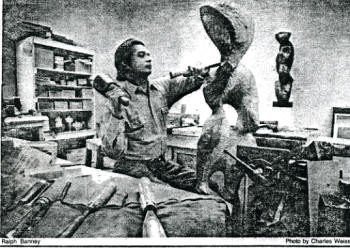
Ralph Baney was too comfortable as an artist. Though he reveres the smooth, graceful grain of wood, he thought it was necessary to step away from it and find a new medium for his sculpture.
The results, gigantic ceramic designs, are now on exhibit at Catonsville Community College, one of eight sites of the Maryland Artists Exhibition
The Sulphur Spring Road resident has two pieces of his ceramic sculpture on exhibit: "Altar" and "Refugee."
"I was too comfortable working with wood," he explains in the studio he built last year
behind his house. "My own
philosophy is: an artist has to set himself new problems and new
challenges and to go into new and and uncertain areas for him."
Although his wife, Vera, is a professional sculptor who works primarily in ceramics, Baney said her work really didn't influence his decision to take on clay. He said, however, that she has provided him with unflinchingly truthful criticism of his work. That avenue goes both ways, he added.
Baney , an art professor at Dundalk Community College, has enjoyed a far-ranging art career since his days in his native Trinidad.
He studied art at Brighton College of Art in England and earned his master of fine arts degree and doctorate at the University of Maryland. His sculpture has been shown from New York to Brazil with exhibits in Trinidad and England. Private collectors from as far away as New Zealand have bought his creations. Most of that work was in wood, the medium Baney most prefers. "I can relate better to wood than to any other sculpture material," he said. He appreciates its warm qualities and the flowing lines of the grain.
Those flowing lines always seem to be revealed in the lines of the huge nonfigurative sculptures the artist produces.
I cooperate with the wood', he explains, running his hand down the curve of a piece he is currently working on. "In a way I do what the wood tells me to do".
But ceramics, his new sculpting material, isn't as cooperative. It provided the challenge the Arbutus artist wanted.
Yet he still has found a way to force the large pieces to defy gravity, to twist into shapes wet clay doesn't want to take.
The huge piece "Refugee" for example, combines three almost spherical shapes atop one another. "Altar" includes a piece of walnut wedged between the supporting legs and three cones balanced on top.
"I didn't want it to be very specific," he says, although, he adds, the shape of "Refugee" includes an indentation at the top which could represent a cry.It was that symbol that earned the work its name. "Altar" was named because Baney thought the work should be approached with reverence.
Area residents can see his work, along with that of 14 other artists, in the gallery at CCC in the Humanities Building. But the exhibit is about to dose. The last day is this Sunday, March 6.
Gallery hours are Monday through Saturday, 10 a.m. to 4 p.m. On Saturday, the gallery will be open 12 - 5 p.m.

